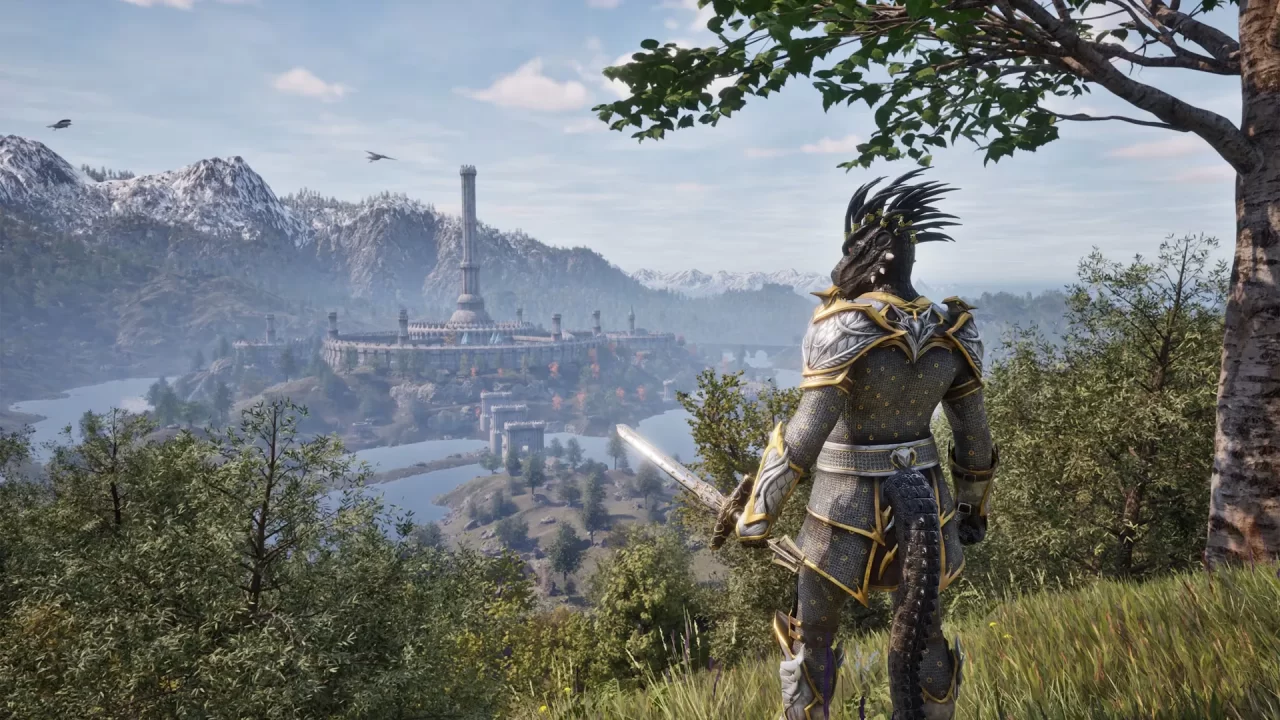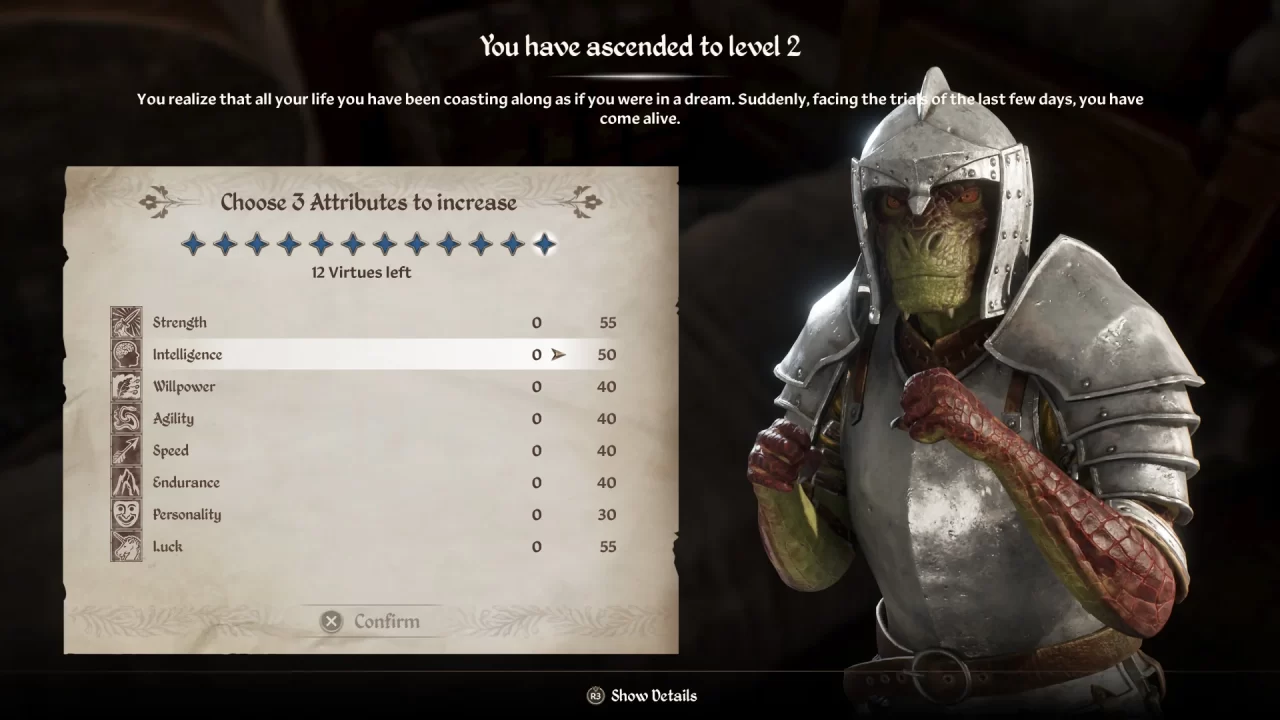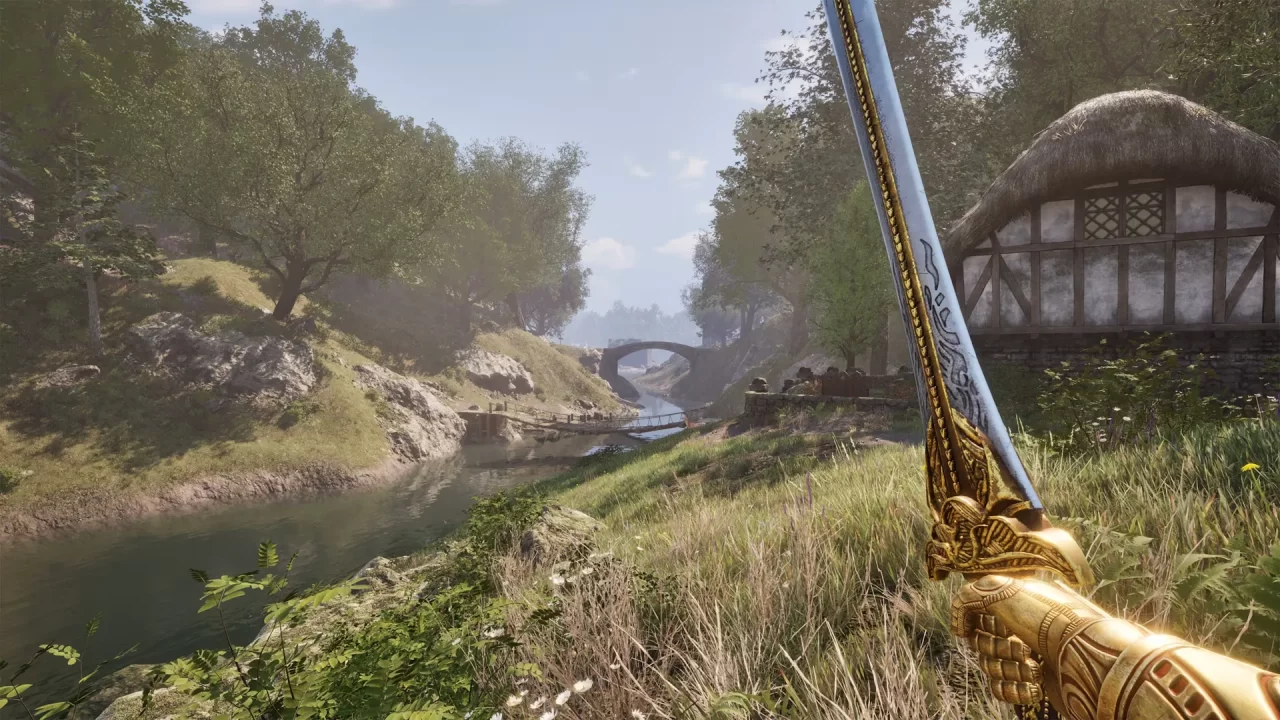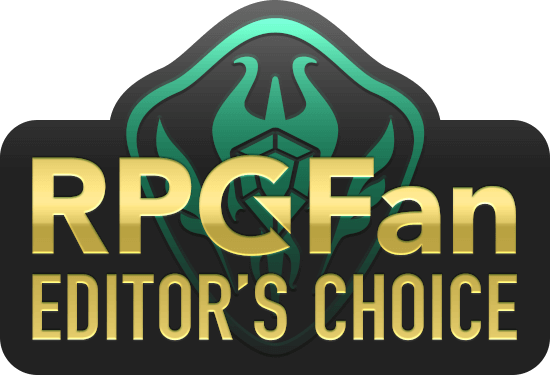Middas afternoon, 5th of Heartfire, in the year 433 of the Third Era. When the Fighter’s Guild put me on to solve Arvena Thelas’ “rat problem,” I thought I’d be cleaning a basement of rabid vermin, not saving her precious pet rats from an intruding mountain lion. Now I follow a local hunter, Pinarus Inventius, outside the city to hunt for the lions at their source. In a voice oddly familiar, as if shared by a hundred others, Pinarus tells me to be on the lookout for the lions. He doesn’t acknowledge the three full-grown mountain lions standing just a stone’s throw away, staring glassy-eyed past us into nothingness. I gasp. Calmly and with blade sheathed, Pinarus pivots and strolls ahead, nudging one lion aside until he’s between all three. Suddenly, the hunter tears his sword out and begins the fight with a savage cry to the lions: “This is the part where you fall down and BLEED TO DEATH!” All three lions come to life and pounce. Within a few furious moments we’ve slain the beasts—they roll endlessly at our feet like giant golden rotisserie chickens. Pinarus congratulates me with a huge, beaming grin. Yet, when I make to speak with him again, his face darkens and he growls at me like we haven’t just battled alongside each other, “I’m done talking to you!” Baffled and a little stung, yet nonetheless satisfied at a job done, I return to the city to continue my investigation into who’s been leaving meat outside Thelas’ basement door, drawing the lions there in the first place.
It’s been nearly two decades since the original release of The Elder Scrolls IV: Oblivion shook the world and popularized the trend of a huge, fully traversable open world where hundreds of side quests, like hunting for pet rat-eating mountain lions, arguably take precedence over the main story. When I think back to my eleven or twelve-year-old self playing it on a borrowed Xbox 360 and later a PS3, it’s the quirky jankiness of NPCs (like lion hunter Pinarus Inventius) I most fondly remember, with any and all bugs feeling absolutely permissible given the massive scale of the game’s country, Cyrodiil. When whispers of an Oblivion remaster began to circulate, I wondered if Bethesda would de-jank and sap the charm from one of my favorite Western RPGs of all time, giving us a primitive version of the many open-world RPGs that have followed it. With the shadow drop of The Elder Scrolls IV: Oblivion Remastered last week, I need no longer worry. Oblivion Remastered looks like a proper modern release, it runs more smoothly than ever (more smoothly than perhaps any Bethesda game at launch), and it retains the uniquely antiquated RPG mechanics and playful atmosphere that embedded the original in the hearts of so many fans.
First off, what changes does Oblivion Remastered bring? The Gamebryo engine on which the original Oblivion (plus Fallout 3 and Fallout: New Vegas) ran is still present for gameplay, meaning the game moves and feels just like old times. Layered on top, though, are the completely redone visuals in Unreal Engine 5. Cyrodiil’s hills, skies, and flora look beautiful, especially with the new lighting effects. Its inhabitants… look texturally great, with new and more distinct race models (various humans, elves, the lizard-like Argonians, and the lion-like Khajiit) while keeping their uncannily emotive and sometimes frightening faces. Oblivion Remastered runs buttery smooth when indoors, and, uh, slightly chunky margarine-smooth in the open world. I only ever stopped play sessions with the 2006 original when it inevitably crashed on me, but Oblivion Remastered has only crashed twice in the many hours I’ve invested so far. Each area loads within seconds, so navigating houses and fast-traveling through fetch quests feels like less of a chore.
Player physics have also changed to make swinging melee weapons a tad meatier (but it still mostly feels like you’re slicing air with a pool noodle) and to change traversal speeds depending on slopes, meaning you feel less like a frictionless first-person camera gliding over hills. Oblivion Remastered‘s updated UI introduces more logical menu layouts, and other small quality-of-life features from later Bethesda games are present, such as player cursors showing when a chest is empty or not, step distance on compass objectives, and the ability to sprint. NPCs feature additional voice work, mostly to further differentiate the races from each other, giving us fewer vocally identical Nords and Orcs.
Most notably, Oblivion Remastered features an updated leveling system. You still pick 7 of the 21 skills to be your “major skills,” though leveling major or minor skills will now contribute to your overall player level. You still level said skills to a max of 100 by using them, encouraging you to try out blades, blunt weapons, bows, and the various magic types, as well as running, jumping, bartering, wearing various armours, and so on. When it’s time to rest and increase your player level, the game now lets you freely assign twelve points to any attribute (Strength, Wisdom, Persuasion, etc.), regardless of whether they’re linked to the skills you’ve been leveling. Whereas in the 2006 Oblivion it was possible to under-level essential skills and get locked in a world where enemies beef up to match your overall player level (leading to some unwinnable encounters among other problems), Oblivion Remastered makes it easier to course-correct an overly charismatic hero who is nevertheless unable to talk down a damage-sponge mudcrab from pinching him to death. Like I did as a kid, I constantly engaged with the game’s many playstyles, bunny-hopping around and casting self-buffing spells to raise skills to a point where I unlocked new abilities. Why start a new playthrough when I can eventually be a jack of all trades, master of all?
Oblivion’s main story is serviceable fantasy-fare, though I’m willing to bet most players have never bothered to see the main questline’s ending. Your user-created character is a prisoner who catches the eye of Emperor Uriel Septim VII (voiced by the great Sir Patrick Stewart, though there is no new voice work) moments before his assassination at the hands of an unholy cult. It’s up to you to find the emperor’s hidden heir (a solid vocal performance by Sean Bean), preserve the Septim bloodline, and put a stop to the rise of daemonic gates from the hellish planes of Oblivion rising across Cyrodiil. This questline is a good excuse to visit all of Oblivion’s main cities, though once the tutorial finishes and the game drops you into its open world, you’re likely to progress through a smattering of side quests from chance encounters obtained from exploration and town gossip to the major guild chain quests. There is a freedom of when, what, and how you quest that was largely unprecedented in 2006, and the game’s immediate ability to fast-travel to any major town lets new and veteran players play how they want.
These side quests are the real standout, and often flip the fantasy-RPG tropes that the main story plays so readily into. Each of Cyrodiil’s towns looks and feels unique, and talking to the locals will embroil you in anything from investigating the supernatural disappearance of a painter in Cheydinhal, to helping a paranoid elf convinced he’s being watched by the people of Skingrad, to deducing the culprit who stole the portrait of Castle Chorrol’s late Count Valga from the Countess’ bed chamber. Oblivion has a great sense of humour and atmosphere, lighter and quirkier than The Elder Scrolls V: Skyrim (2011) and certainly less cynical than Bethesda’s Fallout entries, and this campiness shows most clearly in the side content—though calling 90% of the game “side” content feels unsuitable.
In addition, you have the guild and other association quest chains. There are chapters of the Mages Guild and the Fighters Guild (a sort of mercenary band) in most towns that’ll send you on a huge variety of quests. Talk of a legendary thief and his loyal guild purvey the huge Imperial City in Cyrodiil’s centre, home of the gladiatorial arena. And should you choose to murder an innocent, you can expect a visit in the night from the mysterious Dark Brotherhood. There are well over 200 quests in Oblivion, with plenty of creative hits (and a fair number of simplified duds). My advice is to fast-travel to cities and join the major guilds as soon as you can, then seek out rumours in each city those take you to. Exploring the vast wilds in Oblivion may once have been its main draw, and there are still valuable experiences to stumble upon, but the rewards you get for clearing random dungeons are mostly negligible, and odds are, that area you clear is related to a side quest you can find and start from elsewhere. Also worth noting is that all the DLC quests from Oblivion reappear, including the Knights of the Nine questline and the sizable Shivering Isles. However, the Horse Armour Pack, which so infamously ignited internet rage in 2006 but arguably led to the proliferation of paid DLC in gaming (for better or worse), is limited to the Deluxe Edition. Well-played.
Jeremy Soule’s original score is untouched. The music is warmer and more wistful than Skyrim’s epic themes, and shines in its daytime exploration themes. Hearing tracks like “Sunrise of Flutes” alongside the updated lighting is very moving, speaking as a big fan of the soundtrack. My only complaint is that we didn’t get more of it, or at least re-recordings.
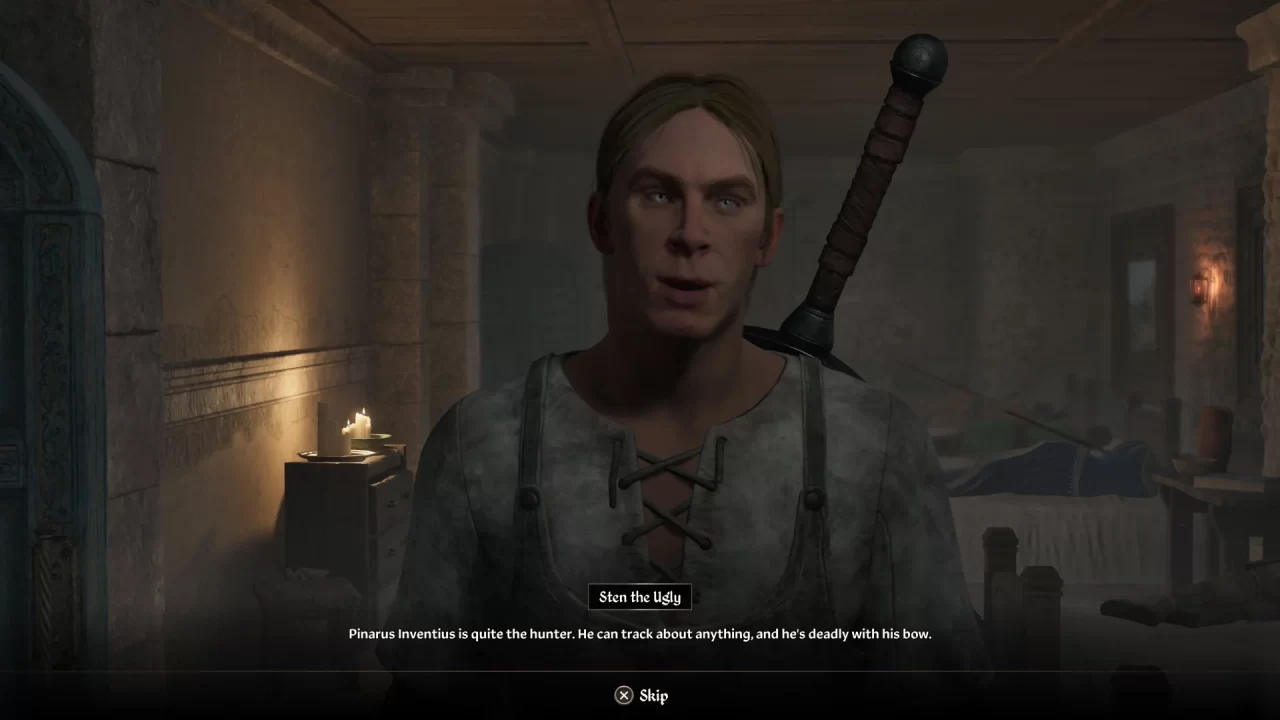
Lastly, let’s address the jank. Though this is a polished launch by Bethesda’s standards, plenty of bugs still plague the game. The “Starlight” spell won’t illuminate you unless you switch to third-person. NPC dialogue will sometimes not trigger the voice, and the line will quickly skip before you can read it (this is especially egregious in dialogue linked with the Knights of the Nine quests). Overall, though, the original’s technical hiccups have been ironed out—except, that is, for the fun ones. NPCs still awkwardly trudge around having nonsensical conversations with each other. Killing enemies will sometimes cause their clothing to unequip and fly off, or an oddly placed punch may launch them into the stratosphere. There’s still only a handful of voice actors for the many, many NPCs, their lines are still laughably corny, and the devs purposefully kept in instances of actors flubbing and even double-taking line reads. I struggled with whether to praise or demerit Oblivion Remastered for this, but my heart tells me that this is key to the game I long ago fell in love with, warts and all. To de-jank Oblivion would be to steal its soul, and I’m glad Bethesda and assistant devs Virtuous so proudly kept the goofiness.
The Elder Scrolls IV: Oblivion Remastered does what every great remaster ought to: it recaptures the fun and silliness of the original, quietly removes some underlying flaws, and makes the whole experience look as beautiful as memories seen through rose-tinted glasses. “I’m done talking to you! Be seeing you.”

